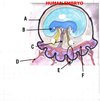Embryology 1 Flashcards
What are the different phases of embryology?
Pre-embryonic phase (0-3 weeks)
Embryonic phase (4-8 weeks)
Foetal phase (9-40 weeks)
Postnatal
What does the pre-embryonic phase last between?
0-3 weeks
What does the embryonic phase last between?
4-8 weeks
What does the foetal phase last between?
9-40 weeks
What is spermatogenesis?
Process by which a haploid spermatozoa develops from germ cells in the seminiferous tubules of the testis
What is the process by which a haploid spermatozoa develops from germ cells in the seminiferous tubules of the testis called?
Spermatogenesis
What is oogenesis?
Process of development of ova that takes place in the ovaries
What is the process of development of ova that takes place in the ovaries known as?
Oogenesis
What is produced during spermatogenesis?
4 spermatozoa (sperm) are produced from one spermatogonium
What is produced during oogenesis?
1 ova and 3 polar bodies are produced from one oogonium
What is spermatogonium?
Cell produced at an early stage in the formation of spermatozoa
What is the precurser for spermatogenesis?
Spermatogonium
What is oogonium?
Immature female reproductive cell that gives rise to primary oocytes by mitosis which go on to produce ova by meiosis
What is the precruser of oogenesis?
Oogonium
How many chromosomes do spermatogonium and oogonium have?
46 chromosomes
How does each sperm and ova compared to other sperm and ova?
Each one is genetically unique
What happens during fertilisation?
Several sperm surrounds the ovum, where one penetrates and its nucleus enters and fuses with the nucleus of the ovum to give a diploid cell called the zygote
What is a zygote?
Fertilised ovum
What happens during week 1 of the pre-embryonic phase?
Zygote is formed and divides to form a blastocyst
Blastocyst moves through uterine tube to reach uterine cavity
During what week is the zygote formed and divides to form a blastocyst?
Week 1
During what week does the blastocyst move through the uterine tube to reach the uterine cavity?
Week 1
How many chromosomes does a zygote have?
46 (diploid)
Why is each zygote genetically unique?
23 of mothers chromosomes and 23 of fathers chromosomes
Where does a zygotes mitochondria and cell organelles originate from?
Mother
What does a zygote divide to form?
Morula by dividing by mitosis
What is a morula?
Solid ball of cells
What does mitochondria being inherited from the mother mean in terms of genetic disease?
Mitochondrial genetic diseases cannot be inherited from the father
What is an example of a mitochondrial disease?
Leber’s disease
Hereditary optic neuropathy which leads to blindness
What is Leber’s disease?
Hereditary optic neuropathy which leads to blindness
What occurs during the development of the blastocyst from the morula?
1) As the number and size of cells increase getting nutrition to the central core of the cells becomes difficult
2) Cavity develops called the blastocystic cavity
3) Cells accumulate at one end to form an inner cell mast
4) Outer lining of cells is called the trophoblast
What is the cavity in a blastocyst called?
Blastocystic cavity
What is the outer lining of a blastocyst called?
Trophoblast
What does the zygote do once it is formed?
Moves through the uterine tube to the uterine cavity
Where is the ovum released from?
Ovary
Where does fertilisation occur?
Fallopian tube
Where does development from zygote to morula to blastocyst occur?
As it travels through the uterine tube to the uterine cavity
How long does the first cell division of the zygote take?
36 hours
What happens to the time of each cell division after the first?
Successive cell division takes lesser and lesser time

























